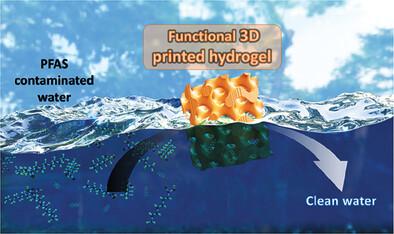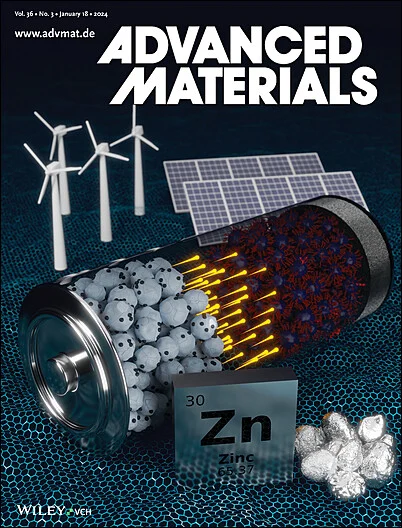Efficient PFAS Removal Using Reusable and Non-Toxic 3D Printed Porous Trianglamine Hydrogels
IF 27.4
1区 材料科学
Q1 CHEMISTRY, MULTIDISCIPLINARY
引用次数: 0
Abstract
Per- and polyfluoroalkyl substances (PFAS) are now a paramount concern in water remediation. Nowadays, urgent action is required for the development of advanced technologies aimed at capturing PFAS and mitigating their impact. To offer a solution, a functional 3D printed hydrogel tailored is designed to trap a broad spectrum of PFAS contaminants. The hydrogel is made of a photo-crosslinked dimethacrylate-ureido-trianglamine (DMU-Δ) and Pluronic P123 dimethacrylate (PDM) fabricated by stereolithography (SLA). With the aid of 3D-printing, porous and nonporous hydrogels (3D-PSHΔ, 3D-SHΔ) as well as quaternized hydrogels (3D-PSHΔQ+) are prepared. These tailored hydrogels, show high uptake capacities and fast removal kinetics for PFAS from aqueous sources. The PFAS removal efficiency of these hydrogels are then compared to P123 hydrogels with no trianglamine (3D-SH). The 3D-SH hydrogel shows no affinity to PFAS, proving that the sorption is due to the interaction between the trianglamine (Δ) and PFAS. Metadynamic simulations also confirmed this interaction. The porous matrices showed the fastest and highest uptake capacity. 3D-PSHΔ is able to capture ≈ 91% of PFAS within 5 h using initial concentrations of 5 and 0.5 ppm in both deionized and river water. The sorption of PFAS is further enhanced by introducing permanent positive charges to the structure of the porous hydrogels, resulting in even faster sorption kinetics for both long and short PFAS chains with diverse polar heads. Besides the remarkable efficiency in capturing PFAS, these designed hydrogels are non-toxic and have outstanding chemical and thermal stability, making them a brilliant candidate for mass use in the combat against PFAS pollution.

利用可重复使用的无毒 3D 打印多孔 Trianglamine 水凝胶高效去除 PFAS
全氟烷基和多氟烷基物质(PFAS)目前已成为水质修复领域的头等大事。如今,迫切需要开发先进的技术来捕捉 PFAS 并减轻其影响。为了提供一种解决方案,我们设计了一种量身定制的功能性 3D 打印水凝胶,用于捕捉各种 PFAS 污染物。这种水凝胶由光交联二甲基丙烯酸酯-脲基三聚氰胺(DMU-Δ)和 Pluronic P123 二甲基丙烯酸酯(PDM)通过立体光刻技术(SLA)制成。借助三维打印技术,制备出了多孔和无孔水凝胶(3D-PSHΔ、3D-SHΔ)以及季铵化水凝胶(3D-PSHΔQ+)。这些定制水凝胶对水源中的全氟辛烷磺酸具有较高的吸收能力和快速去除动力学。然后将这些水凝胶的 PFAS 去除效率与不含三聚氰胺的 P123 水凝胶(3D-SH)进行了比较。3D-SH 水凝胶对全氟辛烷磺酸没有亲和力,这证明吸附是由于三聚氰胺(Δ)与全氟辛烷磺酸之间的相互作用。流体动力学模拟也证实了这种相互作用。多孔基质显示出最快和最高的吸收能力。在去离子水和河水中,初始浓度分别为 5ppm 和 0.5ppm 时,3D-PSHΔ 能够在 5 小时内捕获 ≈ 91% 的 PFAS。通过在多孔水凝胶的结构中引入永久正电荷,进一步增强了对 PFAS 的吸附,从而加快了具有不同极性头的长链和短链 PFAS 的吸附动力学。除了在捕捉全氟辛烷磺酸方面具有出色的效率外,这些设计的水凝胶还具有无毒性和出色的化学和热稳定性,是大规模用于消除全氟辛烷磺酸污染的理想选择。
本文章由计算机程序翻译,如有差异,请以英文原文为准。
求助全文
约1分钟内获得全文
求助全文
来源期刊

Advanced Materials
工程技术-材料科学:综合
CiteScore
43.00
自引率
4.10%
发文量
2182
审稿时长
2 months
期刊介绍:
Advanced Materials, one of the world's most prestigious journals and the foundation of the Advanced portfolio, is the home of choice for best-in-class materials science for more than 30 years. Following this fast-growing and interdisciplinary field, we are considering and publishing the most important discoveries on any and all materials from materials scientists, chemists, physicists, engineers as well as health and life scientists and bringing you the latest results and trends in modern materials-related research every week.
 求助内容:
求助内容: 应助结果提醒方式:
应助结果提醒方式:


